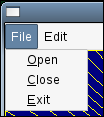Sat Jul 15 22:30:53 CEST 2006
OpenOffice.org menus and native menus
How menus work in practice in OpenOffice.org?In this blog entry, I'll describe how native menus should work. For the description, I'll comment the source code of current aquavcl01 child workspace patched with my patch for menus. I do this because I need to clean up my notes and help also other people to understand what I have now and how to continue.
VCL is a deep magic :-) Too many classes, deep inheritance. I'll try to cast some light into our part and will describe the current status clearly (at least I hope so).
In the vcl's
svdem (the file vcl/workben/svdem.cxx), we extend class
WorkWindow (which itself extends SystemWindow which itself extends class
Window ... OutputDevice ... Resource - now you know what
I meant with "deep magic"):
class MyWin : public WorkWindow
{
public:
MyWin( Window* pParent, WinBits nWinStyle );
...
MenuBar aMenuBar;
PopupMenu aFileMenu;
PopupMenu aEditMenu;
};MenuBar (see declaration) and we will add
two PopupMenus into it (see the declaration
of PopupMenu).

In main, we instantiate the
MyWin class in MyWin aMainWin( NULL, WB_APP | WB_STDWORK );MenuBar and two PopupMenus are created. The method
SalInstance::CreateMenu (AquaSalInstance::CreateMenu, see FIXME: link to
ssa's document about native menus) is called with bMenuBar = TRUE for
the MenuBar and twice with bMenuBar = FALSE
for PopupMenus.
This means that both menu bar and top-level menus are
SalMenu (in our
case, AquaSalMenu) items and are created using the same method!
Now we have menu bar and two
PopupMenu items created and can work with them.
aMainWin.aMenuBar.InsertItem( 1, XubString( RTL_CONSTASCII_USTRINGPARAM( "File" ) ) );
aMainWin.aMenuBar.InsertItem( 2, XubString( RTL_CONSTASCII_USTRINGPARAM( "Edit" ) ) );aMenuBar - "File" (it will be item number 1)
and "Edit" (item number 2). These are actually menu items - SalMenuItem
(AquaSalMenuItems in our case; see the declaration
of SalMenuItem). Notice, that "File" is not a menu, it is a menu item in the menu bar!
This is important.
aMainWin.aMenuBar.SetPopupMenu( 1, &aMainWin.aFileMenu );
aMainWin.aMenuBar.SetPopupMenu( 2, &aMainWin.aEditMenu );aMenuBar is connected with
the PopupMenu aFileMenu.
The first function call will call the method
SetSubMenu with three arguments - the first one is the SalMenuItem
representing "File", the second is the actual SalMenu which should be expanded when
menu item "File" is clicked on. The third argument is the position in the native menu.
FIXME: I do not understand why we have to specify
nPos here too, because the
SalMenuItem already is inserted at some position in the menu bar. Isn't it thus redundant?
aMainWin.aFileMenu.InsertItem( 1, XubString( RTL_CONSTASCII_USTRINGPARAM( "Open" ) ));
aMainWin.aFileMenu.InsertItem( 2, XubString( RTL_CONSTASCII_USTRINGPARAM( "Close" ) ));
aMainWin.aFileMenu.InsertItem( 3, XubString( RTL_CONSTASCII_USTRINGPARAM( "Exit" ) ));
...
aMainWin.aEditMenu.InsertItem( 1, XubString( RTL_CONSTASCII_USTRINGPARAM( "Search" ) ));
aMainWin.aEditMenu.InsertItem( 2, XubString( RTL_CONSTASCII_USTRINGPARAM( "Replace" ) ));The method
InsertItem is already described above. We will create three menu
items - SalMenuItem (AquaSalMenuItems in our case) - and will insert them
into the menu "File", and two into menu "Edit".
aMainWin.SetMenuBar( &aMainWin.aMenuBar );SetMenu of the respective SalFrame object and do other stuff.
So this is the OpenOffice.org side of menus. I'll try to describe the Carbon side of the same soon so we see how to map it into the OpenOffice.org side :-)